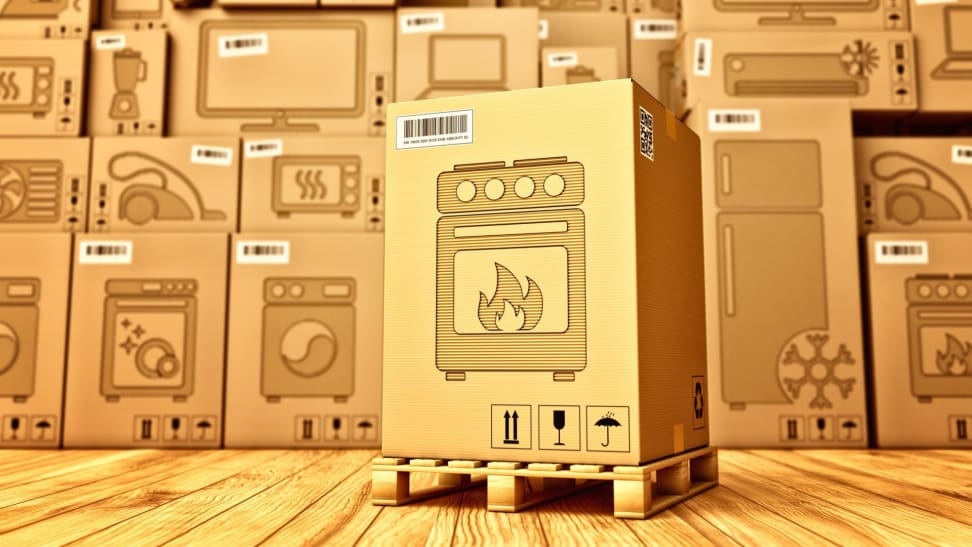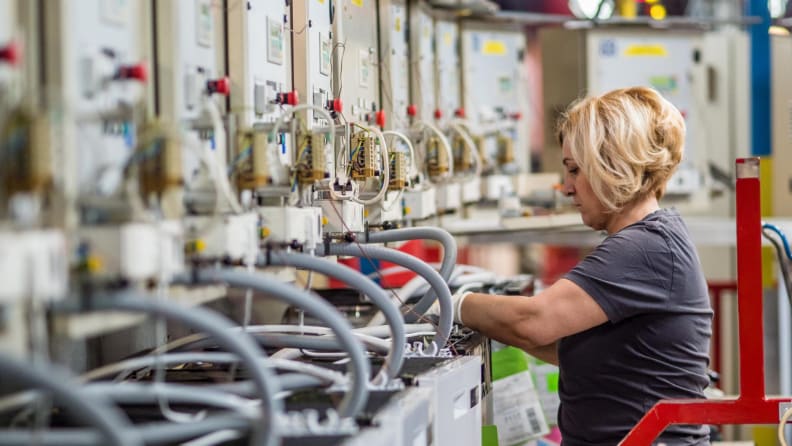Having difficulty buying appliances during COVID-19? Here’s why
Disruptions to the supply chain leaves consumers scrambling
 Credit:
Getty Images / cybrain
Credit:
Getty Images / cybrain
Recommendations are independently chosen by Reviewed's editors. Purchases made through the links below may earn us and our publishing partners a commission. Prices were accurate at the time this article was published but may change over time.
Here’s the scenario. You’re roaming around a big box retailer or your local appliance store trying to pick out and purchase a refrigerator. Back at home, your ice cream is melting onto your kitchen floor and tonight’s steak-tip dinner is morphing into a science lesson on food-borne illness. Your fridge crapped out with no warning, and you need a new one pronto.
However, buying a fridge—or any other major appliance for that matter—is not as easy in 2020 as simply flashing your plastic and setting up a delivery.
Like most things this year, we will blame it on COVID-19. Not only has the pandemic sent tremors through the healthcare industry, our economy, and our social structure, COVID-related circumstances have completely disrupted the supply chains of many industries, from toilet paper and aluminum cans to meat and manufacturing. The appliance industry is no exception.
Why is there a supply chain disruption?
A few factors have played into the appliance industry’s supply chain disruption, and while they’re not all literally because of COVID, they can be traced to our current state of pandemic purgatory.
David Ogilvie, an expert and consultant in ERP and WMS in Australia and the United States, says, “COVID-19 has seen dramatic swings in demand and the respective supply chain's ability to fulfill [the demand] on a wide variety of products.”

Consumers are finding major appliances out of stock this year, due to supply chain disruptions caused in part by COVID-19.
Ogilvie says that any supply chain is subject to “The Bullwhip Effect,” where small shifts in demand at the consumer level gets exponentially amplified at the raw material end of the supply chain.
“In cases like [the pandemic],” he says, “where the shift in demand is so large, the resultant demand on manufacturers at the raw material end of the supply chain suddenly becomes massive and way beyond production capacity.”
All this to say that manufacturers can’t produce sufficient product for a period of time until production catches up. And, this, explains Ogilvie, is what is causing the out-of-stocks that consumers are experiencing.
What has further complicated matters is that factories and manufacturing plants have been closed or limiting staffing because of COVID-19, not only in the U.S., but across the world, which is leading to massive production limitations and an incapability to deliver to demand.
China has the majority of manufacturing capacity at the moment, according to Ogilvie. “Because it was hit with COVID-19 first, the rest of the world saw supply drop even before the impacts of the virus hit our shores,” he says. “So, when the panic buying first hit, and we experienced a combination of supply shortages due to Chinese factories either being closed or on restricted production, and the unheard of demand spikes, it resulted in no availability.”
Half a year into the pandemic, supply constraints are beginning to ease, if slightly.
Major appliance brands have been stressed by increased demand for items like freezers and washing machines. Because of the pandemic, consumers are spending more time at home and realizing with every use of their existing appliance they may be overdue for a replacement or perhaps want to upgrade to a machine with more perks.

COVID-19 has caused supply chain disruptions across every industry, including appliances, from manufacturing to problems at the ports.
John Taylor, senior vice president at LG Electronic USA, says that people are investing in their homes and upgrading their appliances.
“When you look at people who might have been spending money on vacations, and going out to dinner, and concerts and movies, they’re reinvesting those dollars,” Taylor says. “The more time they spend at home the [more they explore] the trends toward healthier living and better cooking.”
Taylor says it’s been a “double whammy,” with the strongest demand LG has seen in years coming up against these supply chain challenges.
So, what do these delays mean for consumers who need to buy major appliances for their homes?
“There are shortages in the industry that vary from brand to brand,” says Taylor, who notes that LG’s global manufacturing presence in Tennessee, Mexico, Thailand, Vietnam, and South Korea allows for some flexibility. “We expect we are going to continue to see constraints apply well into September at this stage.”
How can consumers actually get their hands on an appliance?
There’s waiting, and then there’s waiting. Nobody likes to wait in a germy doctor’s office or in line for a ride at Disney World, and especially not for 60 days for a new oven or fridge—a girl’s gotta eat.
But, these are unprecedented times. I’d like to think we’ve all learned a modicum of patience since the end of February. Sure, it’s incredibly frustrating when you need an essential major appliance for your home and you can’t get one, but making a stink isn’t going to suddenly balance our supply and demand situation.
However, there are a few measures that consumers who do need new appliances can take.
Be flexible
Your biggest challenge is to understand that you may not get exactly what you want right now, so you have a choice: You can suffer through and wait to buy once your desired appliance comes back in stock—which could be months or more—or you can proceed and try something that is available now.
If you want to stay loyal to a brand you love—like Bosch, LG, Electrolux, or Frigidaire—but you can’t find exactly the model you are looking for, perhaps there is another model from the brand that can serve your needs.

If you can’t find the exact fridge or dishwasher model you are looking for, perhaps there is another model from the brand or a similar model from another brand that can serve your needs.
“If you can’t get the full-size refrigerator,” suggests Taylor, “maybe you want to get the counter depth. Think about what your options are, and it might even come down to, well, you can’t get stainless, but this black stainless looks pretty cool.”
On the other hand, consumers who are more a fan of features and the perks that they offer can be flexible when it comes to the brand. Don’t feel like you can’t mix and match appliances from different brands in your kitchen or laundry room. If an appliance from another maker has similar features you love—like, say, custom-temperature deli drawer in a fridge or a third-rack in a dishwasher—then you’ll still be happy.
A final option may be to consider buying an off-brand appliance from a manufacturer that doesn’t have the same name recognition or clout as a major appliance brand like Frigidaire or Samsung.
Sometimes, these are more niche products, like this retro ‘50s-style Smeg refrigerator and this Thor Kitchen dishwasher, and they’re fairly rare when it comes to the appliance space.
A word of caution: When buying off-brand, it’s essential to do some research before buying, reading consumer reviews and more online, so you don’t end up spending a lot of money on a lemon.
Plan ahead and be patient
If you’re not in an immediate-need situation that involves spoiling food or burning laundry, assess where your appliances are at right now, and if you think you’ll be in the market for a replacement in the next couple of months, then plan ahead.
Order now, if you think you can hang on to your existing appliance, i.e. don’t wait for an older appliance to take its last breath.
This thought process also applies if you’re in the middle of a home renovation. Taylor says, “[Despite the pandemic], people are still in the midst of doing intensive planning and looking ahead to getting their new kitchens in place in time for the holidays. Get your orders in now.”
Seek out brand promotions, but be careful
If you do want to go appliance shopping, this may actually be a good time to buy one.
“There were a lot of people out of work, [but] still thinking of upgrading their appliances. We wanted to take the opportunity to have some of the best values of the year for people able to do that,” Taylor says of the promotions LG ran over the Fourth of July holiday. LG is looking ahead to Labor Day and Cyber Monday with even more offers.
A spokesperson from German cleaning and kitchen appliance brand Miele agrees, “We also ramped up promotions on products to help consumers secure items that would make living at home more comfortable, such as coffee systems, vacuums, and consumables to name a few.”
But, just because a brand is offering a killer promotion, it doesn’t mean they have the appliance they’re promoting in stock right now.
“[For] July 4th, some of those products that were on promotion you couldn’t get immediately,” says Taylor. “That was part of the deal. You knew when you ordered them that we expected that this would be delivered in 60 days. We are trying to make sure that there is transparency, that people know. If you can be patient, they’re in the pipeline, it’s in the plan.”
This is especially important to keep in mind as we approach traditionally big promotional sales for Labor Day, Black Friday, and Cyber Monday.
Shop around, and shop local
Take some time to shop around. If you’ve headed to a big box store like The Home Depot, Lowe’s, or Best Buy, and the appliance that you want just isn’t in stock, you may find it worth visiting a few local, independent appliance retailers before settling or pushing off your purchase.
While the selection at big box retailers is large, so is their customer base, which means demand is high there. A local store has a smaller pool of customers, and thus, a better supply-demand balance for the appliances they sell.
Not to mention, buying local also means buying personal. Local appliance retailers tend to be staffed with experienced, knowledgeable salespeople who specialize in major appliances.
What’s more, most small, local appliance retailers have their own delivery and installation teams, as well as dedicated technicians on staff who can come out to your home and perform a service on your appliance the next time you have trouble.





